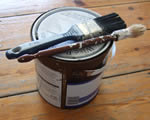 Go to main content
Go to main content
Archive Website of the UK government
Please note that this website has a UK government accesskeys system.
Main menu
Page menu
Home and community

Lead paint removal

Up until the mid-1960s, lead was widely used in household paint. Lead is dangerous if breathed in or swallowed, especially by children. Find out how to identify if you have lead paint in your home and how to deal with it safely.
The risks of lead paint
Up until the mid-1960s, lead was widely used in household paint. It was most commonly used for windows, doors, woodwork and for some metal items.
Lead can be harmful, as it builds up in the body and can be a health risk. Children are more sensitive to its effects than adults.
The lead in old paint becomes dangerous when paintwork is flaking or peeling, knocked or chewed by children or pets. It is also dangerous when sanded or burnt off in preparation for repainting.
You can find out more about the dangers and effects of lead from the Health and Safety Executive (HSE) leaflet. This is primarily for people who work with lead, but contains useful information about how lead gets into your body and its effect on health.
People most at risk from lead paint
The people most likely to be affected by lead paint are pregnant women and young children.
What the law says about using lead paint
It is now illegal for companies to add lead to household paints. There are some exceptions for some listed buildings and for some very limited artistic uses. For more details on the laws on using lead in paint, visit the Department for Environment, Food and Rural Affairs (Defra) website.
How to tell if you have lead paint in your house
The age of your home is a good guide. If it has been built in the last 40 years, it is unlikely you will have any lead paint.
If you live in an older property and your paintwork is quite thick, there could be lead paint locked into the older layers. This is not a problem if the paintwork is in good condition and you don’t plan to redecorate.
If you are unsure whether you have lead paint in your home, you can buy test kits from some retail or trade paint shops. If you suspect you have lead paint, follow the advice below on dealing with it safely.
For more information, use the link below to go to your local council’s website and look for their environmental health department.
How to deal with lead paint safely
The easiest way to deal with lead paintwork, if it is in good condition, is to paint over it with a coat of modern paint. This will seal in the lead and prevent it from causing harm.
If you have to remove lead paint to redecorate, use methods that don’t create dust or fumes, for example:
- use a solvent-based or caustic paint stripper
- choose a water-based, solvent-free paint remover
- use a hot-air gun to soften the paint, but don’t let it get hot enough to burn it off (as this releases fumes)
If you are using a hot air gun, keep surfaces moist when removing paint, and make sure your gun is set to below 450 degrees Celsius.
If you are unsure whether you can safely deal with lead paint, call in a professional, qualified decorator. A list of professional decorating associations is available from the Defra website.
If you use a solvent-based paint stripper, you should dispose of it responsibly at a household waste and recycling centre. Contact your local council to find out where there is one near you.
Safety measures for removing lead paint
There are some simple steps you can take to make it safer to remove lead paint:
- wear protective clothes, gloves, and a good quality face mask
- check your face mask is suitable for working with lead dust
- remove furniture and carpets where possible, or cover them completely
- if you take a break, leave your clothes and gloves in a sealed plastic bag, and wash your hands thoroughly before doing anything else
- use waterproof sandpaper, moistened with water for any sanding – don’t use dry sandpaper
- put the removed paint, and any dust, into a sealed plastic bag and put it out with the general rubbish
- clean the room thoroughly afterwards with a solution of dishwasher detergent
- only use your vacuum cleaner if it is suitable for collecting lead dust – most ordinary domestic models are unsuitable
- when you have finished, wash the protective clothing separately from other clothing
You can find out more about the recommended face mask and vacuum cleaner standards for removing lead paint from the Defra website.
 Facebook
Facebook Twitter
Twitter StumbleUpon
StumbleUpon Delicious
Delicious Reddit
Reddit
